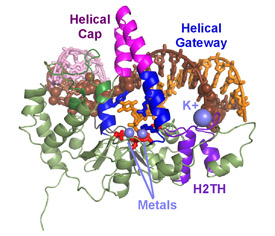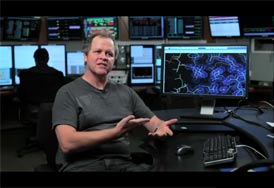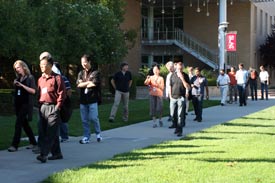__________________________________________________________________________
SSRL Headlines Vol. 12, No. 4 - October 2011
__________________________________________________________________________
Contents of this Issue:
__________________________________________________________________________
1.
From the Director of SSRL: Engaging the User Community
|  |
This year's Users' Meeting and Workshops were a great success with an overflow of attendees from around the world. I would like to thank to the organizers for their effort in planning a wonderful program that included many exciting workshops and the latest scientific results from both the Stanford Synchrotron Radiation Lightsource and the Linac Coherent Light Source. Many new ideas and suggestions were generated at the meeting and we will follow up to implement them.
The FY12 run will start soon, with user operations resuming on most beam lines the week of November 14. I would like to thank the staff for their hard work during the current down time, which allowed us to complete all scheduled improvements to the SPEAR3 accelerator. In this run, we will continue to increase the operating current to reach the 500 mA goal, begin the operation of a new microprobe beamline on 14-3, and start to implement the new SSRL strategic plan.
To better engage the user community, we have recently updated the SSRL user access policy to include a new type of user proposal, the Collaborative Access Proposal (CAP). It is a new program to foster collaborations between user groups and SSRL to enhance or develop a new capability or beam line or to engage in outreach activities to build up a new research area, technique or user community.
CAP proposals will have flexible arrangements depending on the scope of the
proposal including fraction of beam time, resources supplied by the user
group, and mutual expectations for operational support. Proposals will be
reviewed by SSRL Proposal Review Panel. Terms are for two or more years, and
renewable based on review of progress. We encourage user groups with ideas
for this new program to discuss them with us. More information on CAPs, as
well as SSRL's overall user access policy, can be found on the
SSRL website.
We have also received the results from the 2011 Department of Energy review. The report recognized the scientific productivity, high operational efficiency, and progress made in the last 3 years. The reviewers also made several specific comments on SSRL, including:
• "SSRL is a unique and productive synchrotron source" that "may have
the highest user satisfaction among DOE's national facilities"
• The situation at SSRL has improved considerably since the last DOE review
• Much technical progress has been made in exploiting SPEAR3 capabilities
• Continual improvements have been made in accelerator/beamline hardware/software
• Good plans are in place for additional beamlines and strategy for future directions
• The dedication of the scientific and technical staff empowers SSRL’s success
• Short pulse research was praised, especially as it leverages both SLAC's Laboratory Directed Research and Development projects and collaboration with LCLS
The DOE reviewers also expressed that a permanent solution for the SPEAR3 tunnel thermal stability should be implemented; as I announced in my
June column, we are implementing the proposed upgrades to stabilize the temperature of the SPEAR3 tunnel thanks to funds from the Department of Energy Office of Basic Energy Sciences. This project will reduce the photon beam motion at the beam lines by as much as a factor of seven. Finally, the reviewers commented that although the proposal review process is seen as fair, SSRL should include outside input for the allocation of beam time to ensure fairness and transparency in the scheduling process. We are currently working to design such a process and I will announce the final plan in a future column.
As always, we welcome and value feedback—both good and bad. If there are areas where we should know we are doing well or poorly, please share that information either with the instrument scientists with whom you work or
with me directly.
I look forward to all that we will accomplish together in the upcoming user run.
—Chi-Chang Kao
2. Science Highlight —
New Work Solves Conundrum in High Temperature Superconductivity
(contact: Gey-Hong (Sam) Gweon, gweon@ucsc.edu)
|
 |
High-temperature superconductors—which conduct electricity without energy loss at relatively high temperatures—are used in advanced technologies including MRI machines; yet their unusual properties are not well understood, preventing the realization of their full application potential. Many of these unusual properties lie in high-temperature superconductors' normal state, the so-called “strange metal phase.” One of the puzzling characteristics of this strange metal phase is an anomalous
spectral line shape measured by angle resolved photoelectron spectroscopy (ARPES). ARPES—whether conducted with higher-energy synchrotron or lower-energy laser light—offers information about a material's underlying electronic structure by measuring the energy and trajectory of electrons ejected after the sample absorbs a photon. Yet the two photon sources yield two sets of data that, until now, could not both be described by a single theory.
Recently, work led by UC Santa Cruz Physicist Gey-Hong Gweon, based on data obtained at the Stanford Synchrotron Radiation Lightsource, and theoretical work by UC Santa Cruz Physicist Sriram Shastry, offer a single theory that describes the mathematical functions related to electron behavior in high-temperature superconductors and successfully predicts the experimental results seen in both synchrotron and laser ARPES. This work suggests that the two ARPES techniques are in fact consistent with one another:two different perspectives on the same story.
This work was published in a pair of papers published back-to-back in the July 29 issue of Physical Review Letters.
To learn more about this research see the
full scientific highlight.
3.
Science Highlight: Structure of FEN1 with DNA Substrate Revealed
(contact: Susan Tsutakawa, setsutakawa@lbl.gov; and John Tainer, jat@scripps.edu)
|
 |
DNA replication is critical to the life of all organisms, ensuring that each new cell, as well as each new offspring, gets an accurate copy of the genome. Among the legions of proteins that do the work so essential to a cell’s survival, the DNA-slicing protein FEN1 plays a key role.
The structure of human FEN1 as it interacts with a strand of DNA has now been solved by an international team of scientists led by Lawrence Berkeley National Laboratory and
The Scripps Research Institute in La Jolla, conducting their work at both the Stanford Synchrotron Radiation Lightsource and the Advanced Light Source. Previous work determined FEN1's structure when not acting on DNA; but how the protein works was not apparent in this DNA-free structure. The recent work, published in the April 15 edition of
Cell, reveals how FEN1 goes about its task of removing excess single-strand DNA during DNA replication.
FEN1 is essential to health but is also overproduced in many cancers. By better understanding how it interacts with DNA, it may be possible to design more effective drugs that target FEN1's structure, limiting its damaging effects.
To learn more about this research see the
full scientific highlight.
4.
Video: Drug Discovery at SLAC
(Video produced by SLAC Communications)
In this video produced by SLAC, scientists and private-sector drug makers describe how a public–private partnership combined with the specialized
x-rays from the Stanford Synchrotron Radiation Lightsource enable smart drug design that eliminates the costly trial-and-error approach used by traditional drug companies.
Watch the video...
5.
SSRL/LCLS Users' Meeting Highlights Recent Research and Future Plans
Last week's Users' Meeting drew more than 300 registered participants for five days of workshops and talks. Attendees learned about recent and planned upgrades to the Stanford Synchrotron Radiation Lightsource and the Linac Coherent Light Source; research opportunities in catalysis, protein crystallography, materials science and other fields; and recent research by some of the 1,800 scientists who come to use SSRL and LCLS each year. This year's meeting also included a new type of introductory workshop designed to engage new scientists and provide a foundation for existing users to consider adding new techniques to their research toolkit. Photos of the conference can now be viewed on
SSRL's Flickr
photo stream.
If you didn't make it to this year's meeting, please plan to join us in October 2012!
6. Piero Pianetta Honored with Lytle Award
(SLAC News Center article by Helen Shen)
|
 |
Congratulations to Stanford Synchrotron Radiation Lightsource Deputy Director Piero Pianetta, this year's recipient of the Farrel W. Lytle Award. Given annually since 1998, the award recognizes technical or scientific achievements in synchrotron radiation-based science as well as efforts to promote collaboration and efficiency at SSRL.
"I've given quite a few of these away," a surprised Pianetta said after receiving the award Monday night. "When you're the recipient, it's really quite something." He said the award will live in his office "in a place of honor" next to the door where he can see it as he comes and goes.
Beth Wurzburg, who chairs the SSRL Users Organization Executive Committee, presented the award and read from letters submitted in support of Pianetta's nomination. In addition to his experience in experimental techniques and his talent for instrumentation development, Pianetta was recognized for his kind and responsible leadership. Colleagues cited his commitment to the well-being of SSRL users and his everyday presence on the experimental floor.
Farrel Lytle, for whom the award is named, traveled from Nevada to congratulate Pianetta—one of Lytle's earliest friends and colleagues at SSRL. He followed the winner to the podium to be the first to shake his hand and to give an impromptu introduction.
Congratulations, Piero!
7.
Student Poster Award Winners
Congratulations to Catherine Graves, Roopali Kukreja, Inna Vishik, and Samuel Wilson (all
from Stanford University, working with SLAC and/or Stanford faculty) for their
award-winning contributions to the student poster competition held as part of
the annual Users' Meeting:
- The LCLS Vview of All Optical Switching: Uncovering the Nanoscale Origins of Magnetization Reversal.
- The Verwey Transition in Fe3O4: Lattice Distortions on a Femtosecond Time-Scale
- Phase Competition in Trisected Superconducting Dome
- Structure and Reactivity of a Mononuclear Non-Heme Iron(III)-Peroxo Complex
Abstracts for these and other presentations can be
viewed on the
conference website.
A new feature of the poster presentation was a "poster slam" where students gave rapid-fire, one-minute summaries of their poster presentations. In addition to the competition winners, a particularly literary entry came from Mina Bionta (SLAC), who described her research at the LCLS, titled
"Spectral Encoding of X-ray/Optical Relative Delay," in the form of several haikus:
Spectral encoding
Ten femtosec'nd RMS
Measurement error
Ultrafast X-ray pump
Semiconductor membrane
Changes transmission
Ultrafast laser probe
Temporally chirped continuum
Transmits spectral change
Single-shot measure
X-ray to laser delay
Of arrival time
The Users' Meeting itself, which concluded Wednesday, could be summed up in a final haiku
by Helen Shen (SLAC):
Physicists convene
Sharing cutting-edge research
Exploring future
8. Upcoming Events: APS Meeting, SLAC Public Lecture
SLAC to Host November American Physical Society Meeting.
SLAC will host the 2011 meeting of the
American Physical Society's California Section on November 11-12. Plenary talks include Joachim Stöhr (SLAC) on the scientific opportunities with the Linac Coherent Light Source and Alessandra Lanzara (UCB) on recent developments in the area of superconductors. In addition, Nobel Laureate Burton Richter (SLAC) will speak on "Energy Policy Today" after the conference dinner. This meeting also provides an opportunity for undergraduates, graduate students, postdocs, and others to present their research. Learn more and register on the
conference website.
SLAC Public Lecture: Chasing Superbugs - Smart Drug Design.
The next SLAC Public Lecture will be presented by SSRL Scientist Clyde Smith. This event,
which will take place at 7:00 p.m. on Tuesday, November 29, is free and open to the public.
9.
Upcoming Beam Time Request & Proposal Deadlines
(contacts: Cathy Knotts, knotts@slac.stanford.edu; Lisa Dunn, lisa@slac.stanford.edu)
X-ray/VUV Beam Time Requests for February through May 2012 beam time are due Thursday, December 1. Please submit your requests via our
user portal. December 1 is also the next deadline for submitting new X-ray, VUV and Macromolecular Crystallography proposals. New proposals should also be submitted through the user portal.
10. In the News Science at the Theater
Stanford Medical School and SLAC Photon Science Professor Axel Brunger appears at 23 minutes into this video of "Seeing the Light," a Sept. 12 discussion on advances made possible by synchrotron research. The event was part of "Science at the Theater," an ongoing series presented by
Friends of Berkeley Lab, which promotes the importance of scientific advances and is sponsored by Lawrence Berkeley National Laboratory.
See full video on YouTube…
Exhibition in Md. Showcases 'Lost and Found' Text
After more than a decade of restoration and study, the public is getting a glimpse at the oldest surviving copy of works by Archimedes. Most of the text in the Archimedes Palimpsest was recovered using multispectral imaging, but the toughest leaves were taken to the Stanford Synchrotron Radiation Lightsource. There, X-ray beams were used to reveal text beneath the forgery paintings and heavy grime.
Read the full article
on the CBS News website…
SSRL Senior Scientist and His Top Dog Take World Agility Title
SSRL Senior Scientist Ashley Deacon and his Pyrenean shepherd Luka de La Brise—Luka, for short—have been called rock stars of the dog agility world, and for good reason. In the seven years they've competed, the two have jumped, weaved, tunneled, teetered and balanced their way to the front of the pack—winning multiple national championships in both American Kennel Club and U.S. Dog Agility Association competitions.
Read the full article in the SLAC News Center…
__________________________________________________________________________
SSRL Headlines is published electronically monthly to inform SSRL users,
sponsors and other interested people about happenings at SSRL. SSRL is a
national synchrotron user facility operated for the U.S.
Department of Energy Office of Basic Energy Sciences by Stanford
University. Additional support for
the structural biology program is provided by the DOE
Office of Biological and Environmental Research, the NIH
National Center for Research Resources and the NIH National Institute of General Medical
Sciences. Additional information about
SSRL and its operation and schedules is available from the SSRL website.
__________________________________________________________________________
Unsubscribe
To leave the SSRL-HEADLINES distribution, send email as shown
below:
To: LISTSERV@SSRL.SLAC.STANFORD.EDU
Subject: (blank, or anything you like). The message body should read
SIGNOFF SSRL-HEADLINES
That's all it takes. (If we have an old email address for you
that is forwarded to your current address, the system may not recognize who
should be unsubscribed. In that case please write to
ssrl-headlines-request@ssrl.slac.stanford.edu and we'll try to figure out who
you are so that you can be unsubscribed.)
Subscribe
If a colleague would like to subscribe to the list, he or she
should send To: LISTSERV@SSRL.SLAC.STANFORD.EDU and use the
message body SUBSCRIBE SSRL-HEADLINES
| Last Updated: |
31 OCTOBER 2011 |
| Headlines Editor: |
Kelen Tuttle |
|






